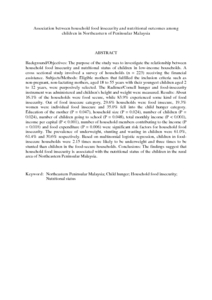Citation
Naser, Ihab Ali and Jalil, Rohana and Wan Muda, Wan Manan and Wan Nik, Wan Suriati and Mohd Shariff, Zalilah and Abdullah, Mohamed Rusli
(2014)
Association between household food insecurity and nutritional outcomes among children in Northeastern of Peninsular Malaysia.
Nutrition Research and Practice, 8 (3).
pp. 304-311.
ISSN 1976-1457; ESSN: 2005-6168
Abstract
Background/Objectives: The purpose of the study was to investigate the relationship between household food insecurity and nutritional status of children in low-income households. A cross sectional study involved a survey of households (n = 223) receiving the financial assistance. Subjects/Methods: Eligible mothers that fulfilled the inclusion criteria such as non-pregnant, non-lactating mothers, aged 18 to 55 years with their youngest children aged 2 to 12 years, were purposively selected. The Radimer/Cornell hunger and food-insecurity instrument was administered and children's height and weight were measured. Results: About 16.1% of the households were food secure, while 83.9% experienced some kind of food insecurity. Out of food insecure category, 29.6% households were food insecure, 19.3% women were individual food insecure and 35.0% fell into the child hunger category. Education of the mother (P = 0.047), household size (P = 0.024), number of children (P = 0.024), number of children going to school (P = 0.048), total monthly income (P < 0.001), income per capital (P < 0.001), number of household members contributing to the income (P = 0.018) and food expenditure (P = 0.006) were significant risk factors for household food insecurity. The prevalence of underweight, stunting and wasting in children were 61.0%, 61.4% and 30.6% respectively. Based on multinomial logistic regression, children in food-insecure households were 2.15 times more likely to be underweight and three times to be stunted than children in the food-secure households. Conclusions: The findings suggest that household food insecurity is associated with the nutritional status of the children in the rural area of Northeastern Peninsular Malaysia.
Download File
![[img]](http://psasir.upm.edu.my/36582/1.hassmallThumbnailVersion/Association%20between%20household%20food%20insecurity%20and%20nutritional%20outcomes%20among%20children%20in%20Northeastern%20of%20Peninsular%20Malaysia.pdf)  Preview |
|
PDF (Abstract)
Association between household food insecurity and nutritional outcomes among children in Northeastern of Peninsular Malaysia.pdf
Download (84kB)
| Preview
|
|
Additional Metadata
Actions (login required)
 |
View Item |

